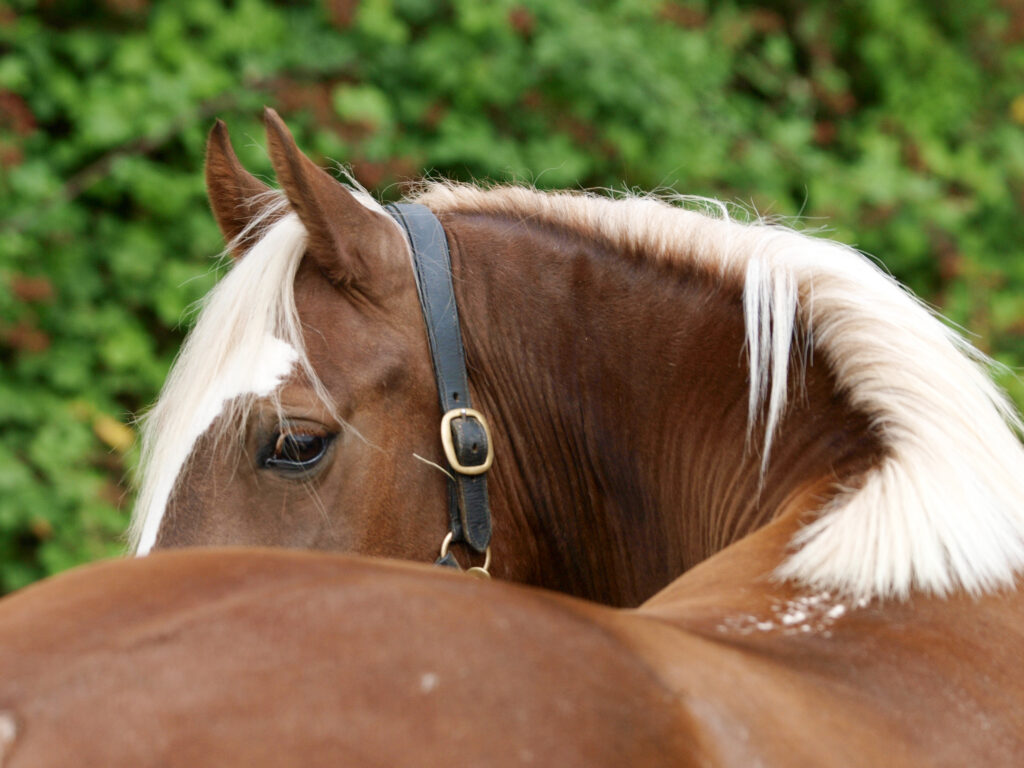
Horses with back pain pose a diagnostic and treatment challenge for equine practitioners. At the 2022 BEVA Congress, Hilary Clayton, BVMS, PhD, DACVSMR, FRCVS, of Michigan State University, tackled this topic with some strategies.
She recommended multiple objectives in the rehabilitation of back pain:
- Stabilize facet joints to decrease micro-motion and risk of future osteoarthritis;
- Restore range of motion;
- Enhance the horse’s proprioception, particularly in tissues around the spine; and
- Build strength and coordination with progressive increases in exercise.
Managing Back Pain in Horses Through Stabilization
Another important element of managing a horse’s back pain relies on reactivating deep stabilizing back muscles such as the multifidus. You can achieve this with dynamic mobilization exercises such as baited stretches using five repetitions per day for three days per week. The lower the horse’s nose stretches down, the greater the angle of the poll and stretch of neck and back tissues. You can ask the horse to pull its chin to the chest, carpi, between front fetlocks, girth, stifle and hind fetlocks. These exercises are relevant to do before tacking up throughout a horse’s career.
Clayton reported that whole-body vibration and neuromuscular stimulation (NMES) are helpful to increase the cross-sectional area of the multifidus muscles.
The range-of-motion (ROM) of the spine in a standing horse is greater than the ROM during locomotion because the horse stabilizes the spine while moving. While baited stretches work wonders for back muscles, stimulated stretches are also helpful: Pressure placed on the linea alba near the withers and pressure on the loins or a hand stroke down the haunches improves pelvic tilt to deepen the pelvic angle. Another technique places slow feeders on the ground so the horse continually lowers the head and neck.
To improve overall back and body stability, when the horse’s center of mass lies above the base of support its destabilization elicits a corrective response. A tail pull moves the center of mass within the base of support. Picking up one leg decreases the base of support, and the horse can be pushed toward the lateral hindlimb. Another simple means of moving the center of mass is to put the horse on unstable surfaces and/or use shoe pads to destabilize the base of support. Balance can be destabilized by changing the way the horse’s limbs move in the swing phase such as walking over poles on the ground or with them slightly elevated. All these techniques to destabilize a horse’s base of support elicit corrective responses that strengthen the back and core muscles.
Proprioception

For proprioceptive improvements and to help a horse’s eye-hoof coordination, use poles, grids, mazes, and up-and-down steps. Ask the horse to move in different directions such as rein-backs, forward turns and circles. Varying surfaces and/or terrain also improve a horse’s proprioception.
Clayton further discussed an oft-asked question, “Lunge or ride, which is the lesser evil?”
If the horse is lunged, she advised starting on a large diameter circle at slow speeds. Also, allow the horse to lean inward to allow ground reaction forces along the long axis of the limb.
A rider’s weight increases lumbosacral joint flexion in both stance and motion phases. The horse’s back slopes downward and forward in front of the croup. The amount of thoracolumbar hollowing is proportional to the weight of the rider.
She stressed that swimming is not recommended for back rehabilitation due to lordosis of trunk that is required for the horse to keep its head up.
As for choice of gait, each has different characteristics.
Walk is associated with low forces, low center of mass trajectory and very little vertical motion of the center of mass. The motion of the back is mainly bending.
Trot is affected by gravity, inertia and ground reaction forces to move the back. As the body rises, the back rounds in suspension and epaxial muscles control the amount of flexion. As the body sinks, the back hollows in the stance phase. Abdominal muscles control extension, and the magnitude of the force is double the rider’s weight. Movement is controlled by eccentric muscle movement.
Rehabilitation at the trot for horses with back pain should start slowly on flat ground with minimal impulsion, i.e., a jog/slow trot. Clayton advised starting with small numbers of steps, alternating between walk and trot. For example, eight trot steps to 20 walk steps. Transitions between walk and trot build strength. With time and improvement, you can add more steps, impulsion and speed.
Saddle Fit

A saddle might no longer accommodate the shape of the back, especially when the horse has had a layoff period compared to steady exercise. In addition, the back shape will change with rehabilitation. Clayton suggested using a sheepskin pad for even distribution of saddle pressure. She urged riders to take note of behavioral signs of back pain or discomfort in their horses.
Core Muscles
Finally, to build strength and coordination of the active core muscles, she recommended using a downhill slope at the walk. Short, controlled steps on an incline promote self-carriage that strengthens thoracic sling muscles. Halt also activates external abdominal oblique muscles to stabilize the trunk.








